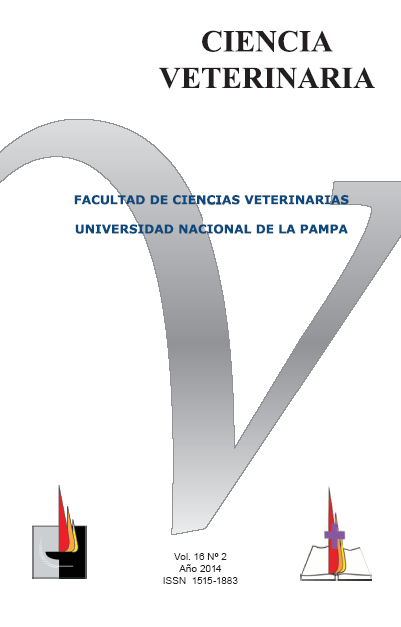Analysis of four methods of decontamination to recover environmental mycobacterium in different ecological niches
DOI:
https://doi.org/10.19137/cienvet20141622Keywords:
mycobacterium, isolation, decontaminationAbstract
When attempting to recover mycobacterium through lab or environmental samples it´s necessary to apply a decontamination method that reduces the accompanying microbiota. It is possible to apply drastic decontamination methods due to the fact that mycobacterium presents a complex wall structure. There are several proposed methods, considering that the ideal method is the one that reduces accompanying microbiota without affecting the number of existing mycobacterium. The objective of this study was to determine decimal reduction of a mycobacterium strain suspension applying the decontamination methods proposed for soil samples, recreational water, tap water and fecal material. A mixed inoculum of mesophilic bacterium was determined (B M) commonly isolated from the environment and another one with a Mycobacterium porcinum strain recovered from tap water. Both inoculums were diluted until a suspension equivalent to a 1 tube of the Mc Farland scale was reached. The real number of bacterium was quantified using the dilution method with base 10. At the same time, three experiments were made to demonstrate decimal reduction when applying different decontaminations methods when trying to recover mycobacterium from soil (Iivanainen, 1995); wetlands (Leite et al., 1989); tap water (Engel et al., 1980); and fecal material (Stabel et al., 1997). Results obtained in this study demonstrated that the Leite et al. (1989) and the Stabel et al. (1997) methods reduced the total number of contaminating bacterium while the number of Mycobacterium porcinum were reduced by 3 and 4 log. Independently applying the methods of Iivanainen (1995) y Engel et al. (1980) reductions of 4 log were obtained in BM contaminants while in the Mycobacterium porcinum strain the reduction varied between 2,5 log and 1 log respectively. It is important to consider the mycobacterium reduction by each different method to correct mycobacterium count numbers in the environmental samples and also so that certain environments are not included as possible habitats of mycobacterium when they are not recovered by conventional methods due to the fact that they may be under the determined reduction valueDownloads
Downloads
Published
How to Cite
Issue
Section
License
Al momento de enviar sus contribuciones, los colaboradores deberán declarar , de manera fehaciente, que poseen el permiso del archivo o repositorio donde se obtuvieron los documentos que se anexan al trabajo, cualquiera sea su formato (manuscritos inéditos, imágenes, archivos audiovisuales, etc.), permiso que los autoriza a publicarlos y reproducirlos, liberando a la revista y sus editores de toda responsabilidad o reclamo de terceros , los autores deben adherir a la licencia Creative Commons denominada “Atribución - No Comercial CC BY-NC-SA”, mediante la cual el autor permite copiar, reproducir, distribuir, comunicar públicamente la obra y generar obras derivadas, siempre y cuando se cite y reconozca al autor original. No se permite, sin embargo, utilizar la obra con fines comerciales.








.jpg)

4.png)


7.png)



